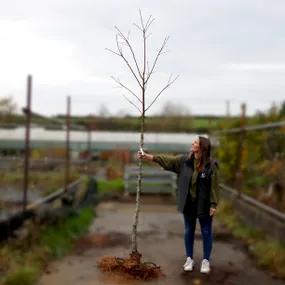Sweet Spanish Chestnut, Large Trees
Honest Delivery Prices- Large, deciduous spreading tree
- Suitable for large gardens, woodland and parkland
- Insignificant flowers.
- Edible nuts
- Max. Height: 25m
Recommended extras
Description
Sweet Chestnut Trees
Castanea sativa, is large, with a stout trunk and strong, fairly short main branches that create a shaggy canopy starting quite close to the ground. Sweet chestnuts, which can reach 30 metres in the right position, will grow on almost any well-drained soil apart from chalk. The nuts are edible - and delicious.
Browse our other varieties of Chestnut trees.
This rugged, deciduous tree has lush, glossy, lance-head shaped leaves with serrated edges that turn bronze-gold in autumn. It produces fairly insignificant pale yellow catkins in June/July which are pollinated by bees and ripen into eating chestnuts in early winter. It is an excellent parkland or woodland specimen. It is a very long-lived tree, and old specimens can be exceptionally beautiful, with thick, spreading branches and intricately ridge bark which seems to spiral around the trunk.
Can I Use Sweet Chestnut in a Hedge?
Yes, but it is a so-so choice for hedging, which is the main reason we don't sell it in smaller sizes. It just doesn't respond well enough to regular trimming to get our vote.
However, it is a fine windbreak tree and coppices beautifully, so it can play an important role in a mixed shelter belt with other trees and hedges.
Did You Know?
Spanish chestnuts were hugely important to the Roman Empire, which spread the species across the Old World and introduced it to Britain some 2,000 years ago. Sweet chestnut porridge was a staple diet for Roman soldiers on campaign; it has all the belly filling stodginess of a grain, combined with the high protein and oil of a nut.
In Sicily, there is an ancient sweet chestnut thought to be over 2,000 years old, the Castagnu de Centu Cavaddi, The Chestnut of One Hundred Horses, sheltered a Spanish queen and her entire company of 100 knights in a storm.
Chestnut wood is strong and almost rot-proof, ideal for outdoor uses such as fencing.
Castanea vesca and Castanea vulgaris are former names.
Planting Instructions
Notes on planting Sweet Chestnut trees:
Sweet Chestnut trees are vigorous and will grow well in any well-drained soil except chalk. They are hardy, but they don't bear good crops in Scotland unless the summer is hot and sunny. Established trees are very drought tolerant. They can grow on the coast. They will not grow well if the site is very shady, wet or on chalk.
Prepare your site before planting:
It is good to dig over the site where you plant a tree several months in advance. Kill the weeds first: for tough weeds like nettles, brambles and ground elder, you will usually need weed-killer to get rid of them. When you dig the soil over, remove stones and other rubbish and mix in well-rotted compost or manure down to the depth of about 2 spades.
Watch our video on how to plant a tree for full instructions.
Remember to water establishing trees during dry weather for at least a year after planting.
Tree Planting accessories:
Prepare your site for planting by killing the weeds and grass.
You can buy a tree planting pack with a wooden stake & rubber tie to support the tree and a mulch mat with pegs to protect the soil around the base of your tree from weeds and drying out.
We suggest that you use mycorrhizal "friendly fungi" on the roots of all newly planted large trees: if your soil quality is poor, we strongly recommend it.
You can also improve your soil with bonemeal organic fertiliser.

 1.webp)
 1.webp)
 2.webp)
